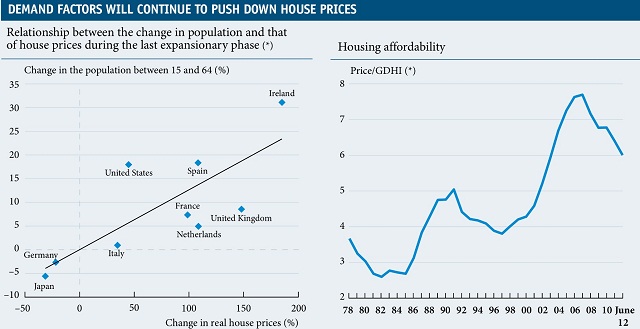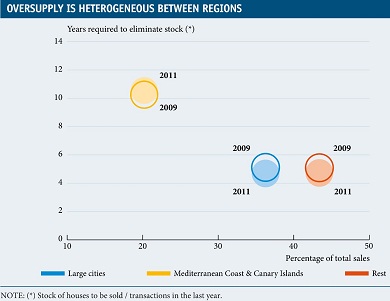The adjustment taking place in Spain’s real estate sector is approaching its fifth year. House prices have accumulated a 25% drop in nominal terms and reverted to 2004 levels. In real terms, once we take the increase of the cost of living into account, this fall rises to 32%.
The adjustment in real estate activity is also substantial. Housing starts have currently dropped to one tenth of their maximum values obtained during the 2006 peak. This is the largest correction in the sector since statistics started and, even so, there are still few signs of this process coming to an end. However, a detailed analysis of the main factors behind this drop, both on the demand and the supply side, as well as the key regulatory changes that will occur, provide some highly relevant aspects for the sector’s future.
In terms of demand, there are two reasons that explain its weakness: new demographic trends and the double dip recession. During the last expansionary cycle, the population increase was exceptional and, as can be seen in the graph below, this helped to push up house prices. This process was spurred on by the baby boomers reaching the age of emancipation. However, this trend has completely changed its direction.
In addition to the progressively ageing population, a significant amount of inhabitants have emigrated abroad. Specifically, the 25 to 39 age group, the most likely to buy a house, has fallen by 281,463 people during the first nine months of 2012. According to forecasts by the National Institute of Statistics (INE), this trend will continue between 2012 and 2014 and the cumulative drop might actually exceed one million inhabitants.
Housing affordability shows some relatively encouraging progress, despite the relapse in economic activity over the last few quarters. The fall in house prices has exceeded that in gross disposable income of households, so that the affordability ratio (computed as house prices as a percentage of gross disposable income of the average household) has improved considerably. For instance, the years of income required to meet the cost of a home has fallen from 7.7 in 2007 to 6.0 years currently.
Despite this considerable correction, the effort to acquire a home is still relatively high compared to historical data. For example, if prices stabilize at around 5.4 times the gross household income, the cumulative fall in house prices would be 33.4%. This implies an additional fall in the price of 10.6%. This drop takes into account an increase in household income in the medium term. Moreover, both lower interest rates and the rise in mortgage maturities observed over the last fifteen years are helping to raise the affordability ratio to higher levels than those observed between 1995 and 2001.
Then, house prices were the equivalent of approximately 4 years’ gross household income. In order to reach this number, an additional adjustment in house prices of 31.7% would be required. In this case, the cumulative drop in house prices would reach 50%.
A detailed analysis of the supply also offers significant distinctions. According to the Ministry of Public Works, the stock of completed but unsold housing in December 2011 was 676,038 units. A figure that is approximately equivalent to six times the cumulative transactions between July 2011 and June 2012. As is well-known, oversupply is notable. But there are important differences around the country. In 2011, those coastal provinces with a high relative weight of tourism had an average stock equivalent to 11.0 years of annual transactions, a figure that has even grown over the last few years (see the graph above). However, in the rest of the provinces, the length of time needed to empty the stock was significantly lower, specifically 4.8 years.
These figures are clearly above the historical ones, traditionally below one year of annual sales. Therefore several years of adjustment are still required. However, given the significant regional differences, the recovery in some zones will start before the sector as a whole has sold all its oversupply. Fortunately, these are the areas where there is most real estate activity.







Be the first to comment on "Spain’s real estate sector: details matter"